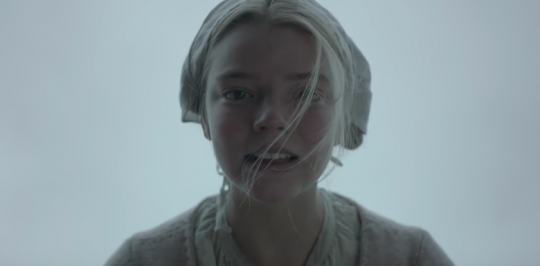I'm going to discuss the whole plot of The Witch below in an effort to dispute some of the critiques of the film. So, if you're not into spoilers, avert thine eyes. If you want a non-spoiler (or, I guess, very modest spoilers) take, you can read my review.
Coming out of The Witch, I felt a bit of dissonance. Robert Eggers’ film is an odd one, in that it's a tale of a witch hunt with an actual witch.
What I mean is, we've been conditioned to treat "witch hunts" as straightforwardly wicked and unjust. The Crucible is largely responsible for this, as Arthur Miller's thinly-veiled morality play about the evils of the anti-communist activities undertaken by HUAC has become a classroom staple over the last half-century. We are taught that witches aren't real and that witch hunts are simply efforts to punish those who have transgressed against the moral majority.
The Witch causes some consternation because it unsettles this narrative in a very peculiar way. It is a movie about a witch hunt that features both unjust persecution and an actual coven of witches tormenting a family.
The Witch opens with a pilgrim family fleeing the plantation where they lived in order to build a new, more righteous home near the woods. Shortly after arriving, the family's newborn, Samuel, is abducted by a witch and mushed into sorceress sunscreen. The witch then charms the family's tween boy, Caleb; he dies of the curse.
In the midst of these tragedies, the family turns on eldest daughter Thomasin. Her mother Katherine believes she is in league with the devil, in no small part because the family's twins, Mercy and Jonas, claim that she has put a curse on them. Father William does not want to believe these ill-spoken words but is given little choice: Thomasin was, after all, the last one seen with both little Samuel and Caleb.
Thomasin—who did herself few favors earlier in the film when she threatened to eat Mercy if the young girl didn't obey her older sister—turns the tables on the twins, claiming that they are in league with the devil. He has taken the form of the family's black-horned ram, Thomasin says, and has been whispering evil into their ears—something the twins actually said happened earlier in the film. This is all part of the classic witch hunt narrative: falsely accused individuals point their finger at other innocents in an effort to shift blame and save their own skins, propagating the horror. It's one of the reasons we consider such activities immoral.
Except, of course, there are really witches out there tormenting the family. We've seen them. And, as it turns out, Thomasin was right. The ram, whose name is Black Philip, is the devil. He was whispering evil nothings into the ears of the twins. And, at the end of the film—after Thomasin's family has turned on her, after they are all dead, after she has stabbed her own mother in the head in self-defense—Black Philip presents her a bargain. She signs the devil's book. She strips off her clothes and walks into the woods. She stumbles upon a coven of witches cackling around a fire, levitating off the ground.
Thomasin smiles. She's home.
Some people get very uncomfortable when it is suggested that Salem-era witchcraft was real, even in the service of an obviously fictional horror film. There's a rather peculiar example of this tic in Andrew O'Hehir's review of The Conjuring, which he denounced as immoral because one of his ancestors was almost punished for being a "witch" more than 300 years ago.
You see something similar in several of the negative reviews of The Witch.
"The Witch purports, at times, to confront ignorance and hysteria, but in the end, for horror thrills, Eggers's film sides with the preachers and executioners," writes Alan Scherstuhl in the Village Voice. "Eggers has appropriated a place and a time and a psychological ethos—Christian fundamentalist religious hysteria in the buildup to the Salem witch trials—and found the one ending that has absolutely nothing to say about it," complains MaryAnn Johanson. "The Witch’s re-creation of colonial life is the scariest part of the movie. This sternness could work if there was no witch at all. Scrap her, and the movie becomes about paranoia," writes Amy Nicholson.
These are all variations on the same complaint: That actual witchcraft in The Witch was unnecessary and that this should have been a tale about the ills of religious extremism and the patriarchy and how paranoia destroys lives.
In other words, The Witch should've been a traditional witch hunt narrative.
But I think The Witch has done something far more interesting. Or, at least, more unique. It's not peddling a traditional witch hunt narrative. It's offering a radicalization narrative. Thomasin's tale is the story of how a young person, marginalized by society and her family, comes to join a radical group. It's a story you see in the news today relatively regularly, one that usually focuses on disaffected young Muslims who, alienated by their perceived mistreatment at the hands of Westerners and languishing in poverty, leave their homes to join ISIS and other terrorist groups. They seek belonging and fellowship. And if they happen to find it amongst killers and psychopaths, well, so be it.
This is why I did not find the film's closing title card—which informs us that dialogue was taken verbatim from primary documents—as silly as Scherstuhl did. It's a reminder that we should pay heed to the words of radicals and understand what it is that drove them into the arms of such groups.
